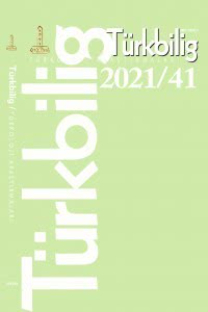SÖZLÜ TARİH VE DESTAN BAĞLAMINDA MACMUATU’T – TAVORİH
Macmuatu’t-Tavorih, Sefeddin ibn Damullo Şah Abbas Aksikenti ve oğluNooruzmuhammed tarafından XV. yüzyılın sonu ile XVI. yüzyılın ortalarındakaleme alınmıştır. El yazmasının müellifi Kırgız olmasına rağmen eserin diliFarsçadır. Kırgız sözlü geleneğine ait Manas Destanı’nın merkezî kahramanıManas’ın adına yer veren ilk yazılı kaynak olması nedeniyle eser, destan ve sözlütarih çerçevesinde ele alınmıştır. Söz konusu eserde Manas, efsanevi kişiliğindensıyrılıp tarihî bir kişilik olarak olaylara dâhil edilmiştir. Bu özellik onun girdiğimücadeleler için de geçerlidir. Manas destanının teşekkülünden sonra kaleme alındığıdüşünülen bu eser aynı zamanda Kırgızların geleneklerini, ritüellerini ve kâinattasavvurlarını ihtiva eden bir içeriğe sahiptir. Çalışmada eser ve içeriği, “destan-sözlütarih ve gerçeklik” bağlamında incelenip değerlendirilmiştir.
Macmuatu't - Tavorih In The Context of Oral History And Epic
Macmuatu't-Tavorih was written by Sefeddin ibn Damullo Shah Abbas Aksikenti and his son Nooruzrmuhammed around the late 15 th century and the early 16 th century. Although the author of manuscript was Kyrgyz, the language of the work is Persian. Considering that it is the first written source referring to the name Manas, the protagonist of the Epic of Manas from the Kyrgyz oral tradition, the work is examined within the context of epic and oral history. In this work, Manas was separated from his legendary personality and characterized as a historical personality. This feature is also true for struggles he was engaged in. This work, considered to be written after the formation of the Epic of Manas, has also a content containing the Kyrgyz traditions, rituals and visions of the universe. This study addressed and discussed the work and its content within the context of "epic-oral history and reality".
___
- ARIKAN, Metin, (2011), “Er Esim/Eşim Destanı Bağlamında Destan-Tarih İlişkisi ve Destanın Oluşumu”, Türk Dünyası Araştırmaları Dergisi, S. 194: 155-167.
- ARVAS, Abdulselam (2009), Dede Korkut Destanı ve Kıpçak Sahası Epik Destan Geleneği, Van: Yüzüncü Yıl Üniversitesi Sosyal Bilimler Enstitüsü Basılmamış Doktora Tezi.
- ERSOY, Ruhi, (2004), “Sözlü Kültür ve Sözlü Tarih Üzerine Bazı Düşünceler”, Millî Folklor, S.61: 102-110.
- ERSOY, Ruhi, (2009), Sözlü Tarih Folklor İlişkisi, Ankara: Akçağ Yayınları.
- İNAN, Abdulkadir (1998), “Epope ve Hurafe Motiflerinin Tarih Bakımından Önemi”, Makaleler ve İncelemeler I, Ankara: TTK Yayınları.
- KAFALI, Mustafa “Ebulgazi Bahadır Han” İslam Ansiklopedisi, C.10, Ankara: Türkiye Diyanet Vakfı Yayınları. (www.islamansiklopedisi.info/Erişim tarihi: 20.4.2018)
- PROPP, Vladimir (1998), Folklor/Teori ve Tarih, (Çev. Necdet Hasgül, Tolga Tanyel), İstanbul: Avesta Yayınları.
- Tarıhtardın Cıynagı “Macmuatu’t-Tavorih” (1996), (Çev. Moldo Mamasabır Dosbolov, Omor Sooronov), Bişkek: “Akıl” Mamkontserni.
- ÜÇÜNCÜ, Kemal, (2004), “ Sözlü Kültür/Tarih Bağlamında Edebî Bir Metin Olarak Otman Baba Vilayetnâmeleri”, Bilig, Kış, S. 28: 1-29.
- YILDIRIM, Dursun (1998), “Tarih Yazımı ve Sözlü Kaynak Ortamı”, Türk Bitiği, Ankara: Akçağ Yayınları.
- YILDIZ, Naciye, (2009), “Manas Destanı ve Muhtar Avezov”, Gazi Türkiyat, S. 5: 259-269.
- YILDIZ, Naciye, (2017), “Manas Destanı’nda Dinî Şahsiyet’in Efsanevi Şahsiyete Dönüşmesi: Ebu Nasır Sâmanî’den Aykoco’ya”, Millî Folklor, S.115: 119-132.
- YILDIZ, Naciye, (1995), Manas Destanı (W. Radloff) ve Kırgız Kültürü ile İlgili Tespit ve Tahliller, Ankara: TDK Yayınları.
- http://tarihvakfi.org.tr/Proje/kilavuzkitaplarvekaynakca/15 Erişim tarihi 22/04/2015.
- ISSN: 1302-6011
- Yayın Aralığı: Yılda 2 Sayı
- Başlangıç: 2000
- Yayıncı: Doç. Dr. Bülent Gül
Sayıdaki Diğer Makaleler
Tibet Budizminde Dharaniler ve Eski Uygurca Sitatapatradharani
TÜRK DİLİNDE YUVARLAKLAŞMA OLAYI VE DUDAK UYUMU
İLHANLILAR'DAN KALAN DİLSEL MİRAS
ROL KURAMI İLE FİİLLERİN ANLAMBİLİMSEL KATEGORİLERİNİN İLİŞKİSİ: İYİ VE KÖTÜ PRENS ÖYKÜSÜ ÖRNEĞİ
MOĞOLLAR’DA YAZILI GELENEĞİN KÖKENLERİ VE “CENGİZ TAŞI”
Âşik Tarzi Şiir Geleneğinin Teşekkülüne Dair Değerlendirmelere Bir Ek: Meyhaneler
DULKADİRLİ TÜRKMENLERİNİN YURTLARI HAKKINDA
TEMEŞVARLI OSMAN AĞA - ESİR, TERCÜMAN VE YAZAR
CUMHURİYET DÖNEMİNDE YAZILAN EDEBİYAT TARİHLERİNDE YENİ TÜRK ŞİİRİ
